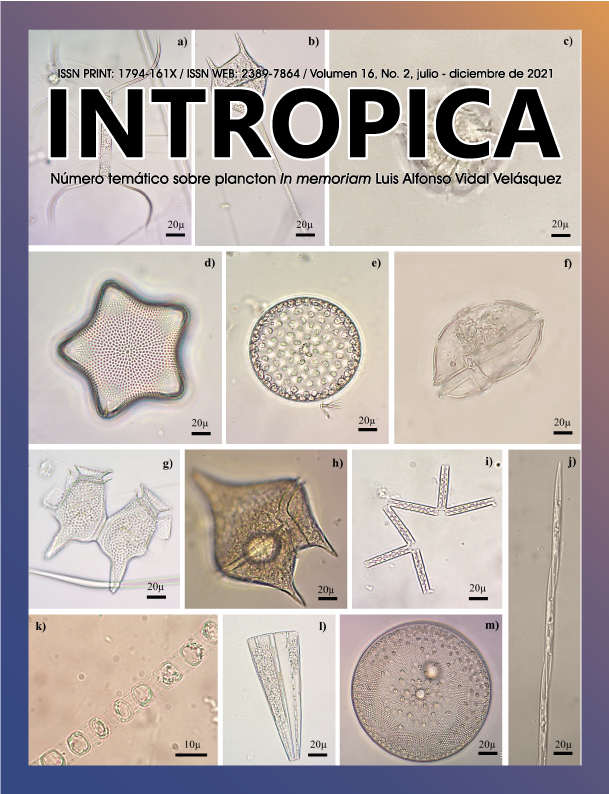Abstract
Diatoms are a successful taxonomic group of microbes, which exhibit a high diversity in marine habitats. Marine epibiont diatoms also display an important diversity of symbiotic associations. Net phytoplankton samples collected in the Mexican Pacific were analyzed, and apart from finding planktonic species, three epizoic diatom species were additionally observed: Protoraphis hustedtiana, Pseudohimantidium pacificum and Sceptronema orientale. The three species, usually found attached to copepods, were studied by light, scanning and transmission electron microscopy (ML, SEM and TEM), showing morphological characters such as shape of the valves, central (and sigmoid) sternum, fine striae, areolae shape, apical and aggregated rimoportulae, and slit fields at the apices (or poles). Morphological details found in Pseudohimantidium pacificum and in Sceptronema orientale include the type of velum in the areolae (rota type) and the external openings of the rimoportulae, respectively. Protoraphis hustedtiana and Sceptronema orientale are new records for the Mexican Pacific.References
Fernandes, L.F. and Calixto-Feres, M. 2012. Morphology and distribution of two epizoic diatoms (Bacillariophyta) in Brazil. Acta Botanica Brasilica 26: 836-841. Doi: https://doi.org/10.1590/S0102-33062012000400012.
Gárate-Lizárraga, I. and Esqueda-Escárcega, G.M. 2018. Ditrichocorycaeus anglicus (Copepoda; Poecilostomatoida), new basibiont of Pseudohimantidium pacificum (Bacillariophyceae) in Bahía de La Paz, Gulf of California. CICIMAR Oceánides 33: 63-67. Doi: https://doi.org/10.37543/oceanides.v33i1.223.
Gárate-Lizárraga, I. and Muñetón-Gómez, M.S. 2009. Primer registro de la diatomea epibionte Pseudohimantidium pacificum y de otras asociaciones simbióticas en el Golfo de California. Acta Botánica Mexicana 88: 31-45. Doi: https://doi.org/10.21829/abm88.2009.311.
Gibson, R.A. 1978. Pseudohimantidium pacificum, an epizoic diatom new to Florida Current (Western North Atlantic Ocean). Journal of Phycology 14: 371-373. Doi: https://doi.org/10.1111/j.1529-8817.1978.tb00316.x
Gibson, R.A. 1979a. An ultrastructure study of Pseudohimantidium pacificum Hust. & Krasske (Bacillariophyceae: Photoraphidaceae) with special reference to the labiate processes. Nova Hedwigia Beihefte 64: 147-161.
Gibson, R.A. 1979b. Protoraphis atlantica sp. nov., a new marine epizoic diatom. Bacillaria 2: 109-126.
Gómez F., Courcot, L. and Artigas, L.F. 2020. Observations of the diatoms Sceptronema orientale Takano and Tabularia parva (Kützing) D.M. Williams and Round on the exoskeleton of copepods in the English Channel and coastal Celtic Seas. Cryptogamie, Algologie 41: 25-30. Doi: https://doi.org/10.5252/cryptogamie-algologie2020v41a4.
Gómez, F., Wang, L. and Lin, S. 2018. Morphology and molecular phylogeny of epizoic araphid diatoms on marine zooplankton, including Pseudofalcula hyalina gen. & comb. nov. (Fragilariophyceae, Bacillariophyta). Journal of Phycology 54: 557-570. Doi: https://doi.org/10.1111/jpy.12760.
Hallegraeff, G.M. and McWilliam, P.S. 1990. The complex labiate process of the epizoic diatom Protoraphis hustedtiana Simonsen. Nova Hedwigia, Beihefte 100: 39-45.
Hasle, G.R. 1978. Diatoms. In: Sournia, A., Editor. Phytoplankton Manual. UNESCO, Paris.
Hernández-Becerril, D.U. and Barón-Campis, S.A. 2008. A new species of the diatom genus Fryxelliella (Bacillariophyta), Fryxelliella pacifica sp. nov., from the tropical Mexican Pacific. Phycological Research 56: 149-155. Doi: https://doi.org/10.1111/j.1440-1835.2008.00496.x.
Hernández-Becerril, D.U., Barón-Campis, S.A. and Ortiz-Lira, H. 2012. A morphological study of epipsammic diatoms (Bacillariophyta) from the tropical Mexican Pacific, including two species of Aulacodiscus and a description of the new species Cerataulus simsae Hernández-Becerril et Barón-Campis. Botanica Marina 55: 73-84. Doi: https://doi.org/10.1515/bot.2011.124.
Hernández-Becerril D.U., Barón-Campis, S.A., Salazar-Paredes, J. and Alonso-Rodríguez, R. 2013. Species of the planktonic diatom genus Skeletonema (Bacillariophyta) from the Mexican Pacific Ocean. Cryptogamie, Algologie 34: 77-87. Doi: https://doi.org/10.7872/crya.v34.iss2.2013.77 .
Hiromi, J. and Takano, H. 1983. Preliminary note on pelagic marine copepods and their epizoic diatoms. Bulletin of the Plankton Society of Japan 30: 171-173.
Kooistra, W.H.C.F., Gersonde, R., Medlin, L.K. and Mann, D.G. 2007. The origin and evolution of the diatoms: their adaptation to a planktonic existence. In: Falkowsky, P.G. and Knoll A.H. Editors. Evolution of primary producers in the sea. Elsevier Academic Press. Cambridge.
Krasske, G. 1941. Die Kieselalgen des chilenischen Kiistenplanktons. Archives für Hydrobiologie 38: 260-287.
Li. L., Chen C., Sun L., Zhang J., Liang J. and Gao Y. 2020. Protoraphis Simonsen, a newly recorded marine epizoic diatom genus for China. Acta Oceanologica Sinica 39: 120-126. Doi: https://doi.org/10.1007/s13131-019-1467-z.
Medlin L.K. and Kacmarska I. 2004. Evolution of the diatoms: V. Morphological and cytological support for the major clades and a taxonomic revision. Phycologia 43: 245-270. Doi: https://doi.org/10.2216/i0031-8884-43-3-245.1.
Rivera, P.S., González, H.E. and Barrales, H.L. 1986. Cingulum and valve morphology of Pseudohimantidium Hustedt & Krasske (Bacillariophyceae). Phycologia 25: 19-27. Doi: https://doi.org/10.2216/i0031-8884-25-1-19.1
Round, F.E. 1971. Benthic marine diatoms. Marine Biology Annual Review 9: 83-139.
Round, F.E, Crawford, R.M. and Mann, D.G. 1990. The diatoms. Biology and morphology of the genera. Cambridge University Press, Cambridge.
Sar, E.A. and Sunesen, I. 2014. The epizoic marine diatom Sceptronema orientale (Licmophoraceae, Licmophorales): epitypification and emendation of specific and generic descriptions. Phytotaxa 177: 269-279. Doi: https://doi.org/10.11646/phytotaxa.177.5.3
Simonsen, R. 1970. Protoraphidaceae, eine neue Familie der Diatomeen. Nova Hedwigia, Beihefte 31: 377-394.
Skovgaard, A. and Saiz, E. 2006. Seasonal occurrence and role of protistan parasites in coastal marine zooplankton. Marine Ecology Progress Series 327: 37-49. Doi: https://doi.org/10.3354/meps327037.
Sunesen, I., Romero, S., Toubes, E. and Sar, E.A. 2015. Morphology and distribution of three araphid diatoms (Fragilariophyceae, Bacillariophyta) from marine coastal waters of Argentina. Iheringia, Serie Botanica 70: 265-78.
Takano, H. 1983. New and rare diatoms from Japanese marine waters-XI. Three new species epizoic on copepods. Bulletin of the Tokai Regional Fisheries Research Laboratory 111: 23-35.
Tiffany, M.A. 2011. Epizoic and epiphytic diatoms. In: Seckbach, J. and Kociolek, P., Editors. The diatom world. Cellular origin, life in extreme habitats and astrobiology . Springer, Dordrecht.
Totti, C., Romagnoli, T., de Stefano, M., Di Camillo, C.G. and Bavestrello, G. 2011. The diversity of epizoic diatoms. Relationships between diatoms and marine invertebrates. In: Seckbach, J. and Dubinsky, Z., Editors. All Flesh Is Grass, Cellular origin, life in extreme habitats and astrobiology 16. Springer Science+Business Media B.V.

This work is licensed under a Creative Commons Attribution-NonCommercial-ShareAlike 4.0 International License.
Copyright (c) 2021 Intropica


